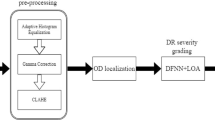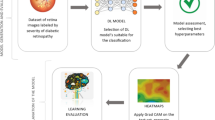Abstract
Diabetic retinopathy is a highly prevalent disease with a global increase in its occurrence. It is characterized by progressive damage to the retina, the light-sensitive lining at the back of the eye. If left untreated, it can ultimately result in permanent blindness. However, accurately determining the stage of diabetic retinopathy is a complex task that necessitates the expertise of experienced medical professionals. In this study, renowned contemporary architectures such as DenseNet121 and InceptionV3 were adapted and modified to predict diabetic retinopathy stages on the dataset obtained from the Kaggle competition - APTOS 2019 Blindness Detection. An explanation technique was employed to localize regions of distinct lesions to facilitate predictions for ophthalmologists. The findings of this study demonstrate that DenseNet121 outperforms other models, achieving a validation classification accuracy of 83.2%.
Access this chapter
Tax calculation will be finalised at checkout
Purchases are for personal use only
Similar content being viewed by others
References
Aiello, L.P., Dcct/Edic Research Group.: Diabetic retinopathy and other ocular findings in the diabetes control and complications trial/epidemiology of diabetes interventions and complications study. Diab. Care 37(1), 17–23 (2013). https://doi.org/10.2337/dc13-2251
Tymchenko, B., Marchenko, P., Spodarets, D.: Deep learning approach to diabetic retinopathy detection. arxiv http://arxiv.org/abs/2003.02261 (2003)
Sun, J.K., Jampol, L.M.: The diabetic retinopathy clinical research network (DRCR.net) and its contributions to the treatment of diabetic retinopathy. Ophthalmic Res. 62(4), 225–230 (2019). https://doi.org/10.1159/000502779
Team, K.: Keras documentation: DenseNet. https://keras.io/api/applications/densenet/
Team, K.: Keras documentation: InceptionV3. https://keras.io/api/applications/inceptionv3/
Dalvi, P.P., Edla, D.R., Purushothama, B.R.: Diagnosis of coronavirus disease from chest x-ray images using DenseNet-169 architecture. SN Comput. Sci. 4(3), 214 (2023). https://doi.org/10.1007/s42979-022-01627-7
Miserlis, D., et al.: Benchmarking EfficientNetB7, InceptionResNetV2, InceptionV3, and xception artificial neural networks applications for aortic pathologies analysis. J. Vasc. Surg. 77(6), e345 (2023). https://doi.org/10.1016/j.jvs.2023.03.475
Mansour, S.E., Browning, D.J., Wong, K., Flynn, H.W., Jr., Bhavsar, A.R.: The evolving treatment of diabetic retinopathy. Clin. Ophthalmol. 14, 653–678 (2020). https://doi.org/10.2147/opth.s236637
Stolte, S., Fang, R.: A survey on medical image analysis in diabetic retinopathy. Med. Image Anal. 64, 101742 (2020). https://doi.org/10.1016/j.media.2020.101742
Antonetti, D.A., Silva, P.S., Stitt, A.W.: Current understanding of the molecular and cellular pathology of diabetic retinopathy. Nat. Rev. Endocrinol. 17(4), 195–206 (2021). https://doi.org/10.1038/s41574-020-00451-4
Grzybowski, A., Brona, P., Lim, G., Ruamviboonsuk, P., Tan, G.S.W., Abramoff, M., Ting, D.S.W.: Artificial intelligence for diabetic retinopathy screening: a review. Eye 34(3), 451–460 (2019). https://doi.org/10.1038/s41433-019-0566-0
Kassani, S.H., Kassani, P.H., Khazaeinezhad, R., Wesolowski, M.J., Schneider, K.A., Deters, R.: Diabetic retinopathy classification using a modified xception architecture. In: 2019 IEEE International Symposium on Signal Processing and Information Technology (ISSPIT), pp. 1–6 (2019). ISSN: 2641–5542
Bodapati, J.D., Shaik, N.S., Naralasetti, V.: Composite deep neural network with gated-attention mechanism for diabetic retinopathy severity classification. J. Ambient Intell. Humanized Comput. 12(10), 9825–9839 (2021). https://doi.org/10.1007/s12652-020-02727-z
Dekhil, O., Naglah, A., Shaban, M., Ghazal, M., Taher, F., Elbaz, A.: Deep learning based method for computer aided diagnosis of diabetic retinopathy. In: 2019 IEEE International Conference on Imaging Systems and Techniques (IST), pp. 1–4 (2019). ISSN: 1558–2809
Kim, J.K., Jung, S., Park, J., Han, S.W.: Arrhythmia detection model using modified DenseNet for comprehensible grad-CAM visualization. Biomed. Signal Process. Control 73, 103408 (2022). https://doi.org/10.1016/j.bspc.2021.103408
Kolekar, S., Gite, S., Pradhan, B., Alamri, A.: Explainable AI in scene understanding for autonomous vehicles in unstructured traffic environments on Indian roads using the inception u-net model with grad-CAM visualization. Sensors 22(24), 9677 (2022). https://doi.org/10.3390/s22249677
Kingma, D.P., Ba, J.: Adam: a method for stochastic optimization (2014). http://arxiv.org/abs/1412.6980
Selvaraju, R.R., Cogswell, M., Das, A., Vedantam, R., Parikh, D., Batra, D.: Grad-CAM: visual explanations from deep networks via gradient-based localization, vol. 128, no. 2, pp. 336–359 (2017). http://arxiv.org/abs/1610.02391
Karthik, M.S.D.: Aptos 2019 blindness detection (2019). https://kaggle.com/competitions/aptos2019-blindness-detection
Prechelt, L.: Early stopping—but when? In: Montavon, G., Orr, G.B., Müller, K.-R. (eds.) Neural Networks: Tricks of the Trade. LNCS, vol. 7700, pp. 53–67. Springer, Heidelberg (2012). https://doi.org/10.1007/978-3-642-35289-8_5
Author information
Authors and Affiliations
Corresponding author
Editor information
Editors and Affiliations
Rights and permissions
Copyright information
© 2023 The Author(s), under exclusive license to Springer Nature Switzerland AG
About this paper
Cite this paper
Pham, N.H., Nguyen, H.T. (2023). Diabetic Retinopathy Diagnosis Leveraging Densely Connected Convolutional Networks and Explanation Technique. In: Dao, NN., Thinh, T.N., Nguyen, N.T. (eds) Intelligence of Things: Technologies and Applications. ICIT 2023. Lecture Notes on Data Engineering and Communications Technologies, vol 188. Springer, Cham. https://doi.org/10.1007/978-3-031-46749-3_11
Download citation
DOI: https://doi.org/10.1007/978-3-031-46749-3_11
Published:
Publisher Name: Springer, Cham
Print ISBN: 978-3-031-46748-6
Online ISBN: 978-3-031-46749-3
eBook Packages: Intelligent Technologies and RoboticsIntelligent Technologies and Robotics (R0)




